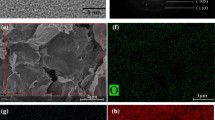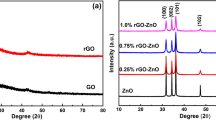Abstract
Heterogeneous photocatalytic oxidation technology is currently a technology with the potential to solve environmental pollution and energy shortages. The key to this technology is to find and design efficient photocatalysts. Here, a series of inorganic coordination polymer quantum sheets (ICPQS)@graphene oxide (GO) composite photocatalysts are synthesized by adding GO to the synthesis process of ICPQS: {[CuII(H2O)4][CuI4(CN)6]}n. These composite photocatalysts were characterized by X-ray diffraction, X-ray photoelectron spectroscopy, cyclic voltammetry, scanning electron microscopy, transmission electron microscopy, Zeta potential, and N2 adsorption/desorption isotherms. The photocatalytic degradation of methylene blue showed that the activity of ICPQS@GO composite photocatalysts is better than that of ICPQS. Among ICPQS@GO composite photocatalysts, the 10.6% ICPQS@GO composite photocatalyst has the best activity, which can reach 3.3 mg/(L min) at pH 3. This method of loading low–specific surface area photocatalysts onto GO to improve photocatalytic performance indicates the direction for the synthesis of highly efficient photocatalysts.









Similar content being viewed by others
References
J.C. Colmenares and R. Luque: Heterogeneous photocatalytic nanomaterials: Prospects and challenges in selective transformations of biomass-derived compounds. Chem. Soc. Rev. 43, 765 (2014).
X.J. Yin and L.G. Zhu: High-efficiency photocatalytic performance and mechanism of silver-based metal–organic framework. J. Mater. Res. 34, 991 (2019).
S. Li, C. Wei, Y. Hu, H. Wu, and F. Li: In situ synthesis and photocatalytic mechanism of a cyano bridged Cu(I) polymer. Inorg. Chem. Front. 5, 1282 (2018).
L. Pasti, E. Sarti, A. Martucci, N. Marchetti, C. Stevanin, and A. Molinari: An advanced oxidation process by photoexcited heterogeneous sodium decatungstate for the degradation of drugs present in aqueous environment. Appl. Catal., B 239, 345 (2018).
E. Mena, A. Rey, and F.J. Beltrán: TiO2 photocatalytic oxidation of a mixture of emerging contaminants: A kinetic study independent of radiation absorption based on the direct-indirect model. Chem. Eng. J. 339, 369 (2018).
J. Saavedra, C.J. Pursell, and B.D. Chandler: CO oxidation kinetics over Au/TiO2 and Au/Al2O3 catalysts: Evidence for a common water-assisted mechanism. J. Am. Chem. Soc. 140, 3712 (2018).
P. Schlexer, D. Widmann, R.J. Behm, and G. Pacchioni: CO oxidation on a Au/TiO2 nanoparticle catalyst via the Au-assisted Mars–van Krevelen mechanism. ACS Catal. 8, 6513 (2018).
C.C. Nguyen, D.T. Nguyen, and T.O. Do: A novel route to synthesize C/Pt/TiO2 phase tunable anatase–Rutile TiO2 for efficient sunlight-driven photocatalytic applications. Appl. Catal., B 226, 46 (2018).
G.L. Chiarello, D. Ferri, and E. Selli: In situ attenuated total reflection infrared spectroscopy study of the photocatalytic steam reforming of methanol on Pt/TiO2. Appl. Surf. Sci. 450, 146 (2018).
S.Y.T. Camacho, A. Rey, M.D. Hernández-Alonso, J. Llorca, F. Medina, and S. Contreras: Pd/TiO2–WO3 photocatalysts for hydrogen generation from water-methanol mixtures. Appl. Surf. Sci. 455, 570–580 (2018).
R. Shen, J. Xie, Y. Ding, S.Y. Liu, A. Adamski, X. Chen, and X. Li: Carbon nanotube-supported Cu3P as high-efficiency and low-cost cocatalysts for exceptional semiconductor-free photocatalytic H2 evolution. ACS Sustainable Chem. Eng. 7, 3243 (2019).
I. Spanopoulos, C. Tsangarakis, E. Klontzas, E. Tylianakis, G. Froudakis, K. Adil, and P.N. Trikalitis: Reticular synthesis of HKUST-like tbo-MOFs with enhanced CH4 storage. J. Am. Chem. Soc. 138, 1568 (2016).
X. Yang and Q. Xu: Bimetallic metal–organic frameworks for gas storage and separation. Cryst. Growth Des. 17, 1450 (2017).
Z. Hasan and S.H. Jhung: Removal of hazardous organics from water using metal–organic frameworks (MOFs): Plausible mechanisms for selective adsorptions. J. Hazard. Mater. 283, 329 (2015).
P.Q. Liao, N.Y. Huang, W.X. Zhang, J.P. Zhang, and X.M. Chen: Controlling guest conformation for efficient purification of butadiene. Science 356, 1193 (2017).
R.B. Lin, S. Xiang, H. Xing, W. Zhou, and B. Chen: Exploration of porous metal–organic frameworks for gas separation and purification. Coord. Chem. Rev. 378, 87 (2019).
Y. Lu and B. Yan: A ratiometric fluorescent pH sensor based on nanoscale metal–organic frameworks (MOFs) modified by europium(III) complexes. Chem. Commun. 50, 13323 (2014).
N.B. Shustova, B.D. McCarthy, and M. Dinca: Turn-on fluorescence in tetraphenylethylene-based metal–organic frameworks: An alternative to aggregation-induced emission. J. Am. Chem. Soc. 133, 20126 (2011).
S.X. Li, B.L. Liao, P. Liao, and Y.M. Jiang: Syntheses, structures, fluorescence and anticancer activity of Co(II) and Ag(I) complexes with 4-(3H)-Quinazolinone. Chinese J. Inorg. Chem. 31, 291 (2015).
B.L. Liao, S.X. Li, and Y.J. Yin: One trinuclear copper(II) polymer based on pyridine-2,4,6-tricarboxylic acid: Synthesis, structure, and magnetic analysis. Russ. J. Coord. Chem. 44, 39 (2018).
B.L. Liao, G.G. Yang, S.X. Li, Y.M. Jiang, and Y.J. Yin: Syntheses, structures and magnetic analysis of Co(II) coordination polymer based on N-(pyridine-3-sulfonyl amino)-acetate. Chinese J. Inorg. Chem. 33, 1843 (2017).
Y.J. Yin, B.L. Liao, H.M. Wu, Y.L. Pang, and S.X. Li: Syntheses, structures and magnetic analysis of Co(II), Ni(II) coordination polymers based on pyridine-2,4,6-tricarboxylic acid. Chinese J. Inorg. Chem. 33, 1043 (2017).
J.J. Jia, S.X. Li, and Y.M. Jiang: Synthesis, crystal structure, and magnetic analysis of Ni(II) polymer based on N-[(3-pyridine)-sulfonyl] aspartate. Inorg. Nano-Met. Chem. 47, 1318 (2017).
I. Hod, M.D. Sampson, P. Deria, C.P. Kubiak, O.K. Farha, and J.T. Hupp: Fe-porphyrin-based metal–organic framework films as high-surface concentration, heterogeneous catalysts for electrochemical reduction of CO2. ACS Catal. 5, 6302 (2015).
W. Chen, B. Han, C. Tian, X. Liu, S. Liang, H. Deng, and Z. Lin: MOFs-derived ultrathin holey Co3O4 nanosheets for enhanced visible light CO2 reduction. Appl. Catal., B 244, 996 (2019).
X. Li, J. Yu, M. Jaroniec, and X. Chen: Cocatalysts for selective photoreduction of CO2 into solar fuels. Chem. Rev. 119, 3962 (2019).
Y. Pi, X. Li, Q. Xia, J. Wu, Y. Li, J. Xiao, and Z. Li: Adsorptive and photocatalytic removal of persistent organic pollutants (POPs) in water by metal–organic frameworks (MOFs). Chem. Eng. J. 337, 351 (2018).
J. Huang, X. Zhang, H. Song, C. Chen, F. Han, and C. Wen: Protonated graphitic carbon nitride coated metal–organic frameworks with enhanced visible-light photocatalytic activity for contaminants degradation. Appl. Surf. Sci. 441, 85 (2018).
M.R. Azhar, P. Vijay, M.O. Tadé, H. Sun, and S. Wang: Submicron sized water-stable metal organic framework (bio-MOF-11) for catalytic degradation of pharmaceuticals and personal care products. Chemosphere 196, 105 (2018).
X. Li, J. Xie, C. Jiang, J. Yu, and P. Zhang: Review on design and evaluation of environmental photocatalysts. Front. Environ. Sci. Eng. 12, 14 (2018).
X. Li, R. Shen, S. Ma, X. Chen, and J. Xie: Graphene-based heterojunction photocatalysts. Appl. Surf. Sci. 430, 53 (2018).
R. Zhang, W. Wan, D. Li, F. Dong, and Y. Zhou: Three-dimensional MoS2/reduced graphene oxide aerogel as a macroscopic visible-light photocatalyst. Chin. J. Catal. 38, 313 (2017).
N. Thirugnanam, H. Song, and Y. Wu: Photocatalytic degradation of Brilliant Green dye using CdSe quantum dots hybridized with graphene oxide under sunlight irradiation. Chin. J. Catal. 38, 2150 (2017).
J. Yan, M. Xu, B. Chai, H. Wang, C. Wang, and Z. Ren: In situ construction of BiOBr/Ag3PO4 composites with enhanced visible light photocatalytic performances. J. Mater. Res. 32, 1603 (2017).
S. Challagulla and S. Roy: The role of fuel to oxidizer ratio in solution combustion synthesis of TiO2 and its influence on photocatalysis. J. Mater. Res. 32, 2764 (2017).
Z. Feng, L. Zeng, Y. Chen, Y. Ma, C. Zhao, R. Jin, Y. Lu, Y. Wu, and Y. He: In situ preparation of Z-scheme MoO3/gC3N4 composite with high performance in photocatalytic CO2 reduction and RhB degradation. J. Mater. Res. 32, 3660 (2017).
S. Li, S. Sun, H. Wu, C. Wei, and Y. Hu: Effects of electron-donating groups on the photocatalytic reaction of MOFs. Catal. Sci. Technol. 8, 1696 (2018).
S. Li, Z. Feng, Y. Hu, C. Wei, H. Wu, and J. Huang: In situ synthesis and high-efficiency photocatalytic performance of Cu(I)/Cu(II) inorganic coordination polymer quantum sheets. Inorg. Chem. 57, 13289 (2018).
H. Yin and Z. Tang: Ultrathin two-dimensional layered metal hydroxides: An emerging platform for advanced catalysis, energy conversion and storage. Chem. Soc. Rev. 45, 4873 (2016).
L. Dou, A.B. Wong, Y. Yu, M. Lai, N. Kornienko, S.W. Eaton, A. Fu, C.G. Bischak, J. Ma, T. Ding, N.S. Ginsberg, L.W. Wang, A.P. Alivisatos, and P. Yang: Atomically thin two-dimensional organic–inorganic hybrid perovskites. Science 349, 1518 (2015).
J. Huang, Y. Li, R.K. Huang, C.T. He, L. Gong, Q. Hu, L.S. Wang, Y.T. Xu, X.Y. Tian, S.Y. Liu, Z.M. Ye, F.X. Wang, D.D. Zhou, W.X. Zhang, and J.P. Zhang: Electrochemical exfoliation of pillared-layer metal–organic framework to boost the oxygen evolution reaction. Angew. Chem., Int. Ed. 57, 4632 (2018).
C. Han, Y. Zhang, P. Gao, S. Chen, X. Liu, Y. Mi, and J. Chang: High-yield production of MoS2 and WS2 quantum sheets from their bulk materials. Nano Lett. 17, 7767 (2017).
M. Xu, S. Yuan, X.Y. Chen, Y.J. Chang, G. Day, Z.Y. Gu, and H.C. Zhou: Two-dimensional metal–organic framework nanosheets as an enzyme inhibitor: Modulation of the α-chymotrypsin activity. J. Am. Chem. Soc. 139, 8312 (2017).
U. Sim, J. Moon, J. An, J.H. Kang, S.E. Jerng, J. Moon, and K.T. Nam: N-doped graphene quantum sheets on silicon nanowire photocathodes for hydrogen production. Energy Environ. Sci. 8, 1329 (2015).
D. Voiry, H. Yamaguchi, J. Li, R. Silva, D.C.B. Alves, T. Fujita, M. Chen, T. Asefa, V.B. Shenoy, G. Eda, and M. Chhowalla: Enhanced catalytic activity in strained chemically exfoliated WS2 nanosheets for hydrogen evolution. Nat. Mater. 12, 850 (2013).
Acknowledgments
This work was supported by the National Natural Science Foundation of China (No. 51878290), Guangxi Natural Science Foundation of China (No. 2015GXNSFBA139242); 2014 school-level scientific research project, Wuzhou University (2014B012), Guangxi Colleges and Universities Key Laboratory of Utilization of Microbial and Botanical Resources, Hechi University (2017HL004 and 2017HJA004), and Master’s degree awarded to the project construction fund.
Author information
Authors and Affiliations
Corresponding authors
Supplementary Material
Rights and permissions
About this article
Cite this article
Li, S., Mo, Q., Lai, X. et al. Inorganic coordination polymer quantum sheets@graphene oxide composite photocatalysts: Performance and mechanism. Journal of Materials Research 34, 3220–3230 (2019). https://doi.org/10.1557/jmr.2019.207
Received:
Accepted:
Published:
Issue Date:
DOI: https://doi.org/10.1557/jmr.2019.207




